BS803: Crop Improvement using Chromosome Numbers:
Making and using Allotetraploids
David Noel
<davidn@aoi.com.au>
Ben Franklin Centre for Theoretical Research
PO Box 27, Subiaco, WA 6008, Australia.

Quotation BS803-Q1.
About chromosome numbers
Living creatures are built up of cells, which all contain chromosomes, strings of genetic material which determine the nature and reproductive mechanisms of the creature. Each chromosome is itself a helical assembly of certain molecules, collectively called DNA (Deoxyribonucleic acid).
Most creatures have a standard number of chromosomes in their cells, this Chromosome Number "n" varies from one creature to another. In normal body cells, the chromosomes are in tightly inter-coiled pairs, the number of pairs is called the Diploid Number for that creature.
There are good sources on the Web giving chromosome numbers of various creatures. For example, the Chromosome Counts Database [1] is a comprehensive compilation of plant chromosome numbers. You can write a plant genus or species name in a search box, and obtain reported chromosome numbers for the searched item.
As an example, the Prunus genus (see Figure F3) contains many well-known fruiting trees, such as the plum, apricot, peach, cherry, and almond. As reported in [1], the majority of Prunus species have a chromosome number (n) of 8 -- that means that in each of the normal body cells of these species, there are 8 pairs of chromosomes. The shorthand for this is 2n=16.
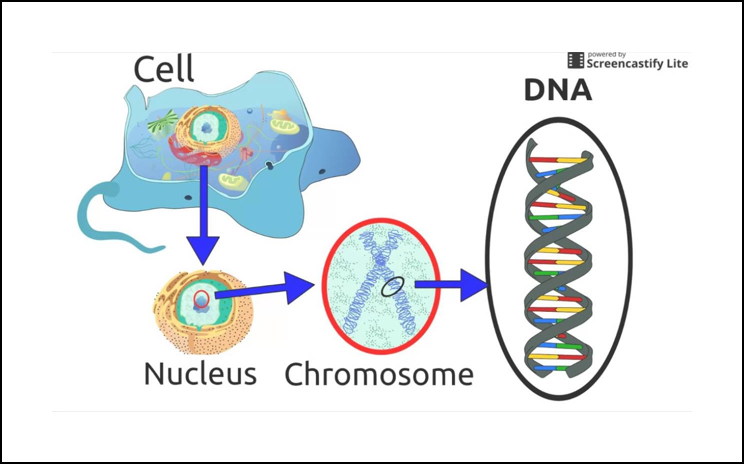
Figure BS803-F1. Cells, chromosomes, and DNA. From [2].
In normal growth of plants, cells are repeatedly dividing into two, making two cells where there was previously one. During this process, each tightly intercoiled pair of chromosomes (the well-known Double Helix), as in Figure F1, uncoils into its component halves (two RNA strands). Each strand picks up material from the cell contents to duplicate itself exactly.
As the cell divides, each duplicate pair separates and moves into opposite ends of the cell, so when cell division is complete, two diploid cells exist, each identical to the one they came from. This is illustrated in Figure F2. There are complexities which are not relevant here, the point is that in normal cell division, the two new cells have the same chromosome number as the original one.
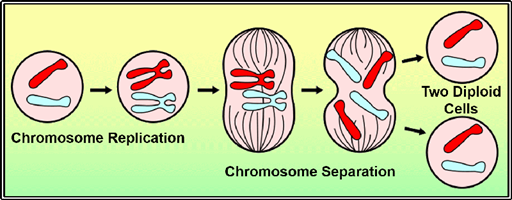
Figure BS803-F2. Chromosome replication and cell division. From [3].
However, various things can go wrong occasionally in the process, and some of these can give cells with more than the original number of chromosomes. Such cells are called polyploids.
Sometimes the number of chromosomes is doubled, with 4 sets, 2 pairs, of chromosomes in each cell. This is called tetraploidy. If the plant undergoes cell division with these cells, it leads to a plant with double the number of chromosomes in each cell, called a tetraploid. In a Prunus species, we may have 4n=32 instead of 2n=16.
Self-fertilization and self-incompatibility in plants
Many of the crop plants which produce our foods are "self-fertile", in the sense that they will produce fruit without pollination from another plant, so a completely isolated tree will produce fruit. This is often called "Selfing".
Selfing behaviour is convenient for human production of plant crops, and so has been selected for in past ages and appears quite normal. With wild plants, however, it is by no means the norm. It is estimated that around half of all species of flowering plants show self-incompatibility [5].
There are a number of reasons why an isolated plant may not be able to produce fruit. The species may have male and female flowers produced on separate plants, or the species may produce both male and female flowers, but at different times.
Another barrier to selfing is where a plant has both male and female parts in its flowers, but its pollen is not accepted by its ovaries -- self-incompatibility. This is common in commercial varieties of almonds. Almond orchards normally need two or more varieties intermixed to produce crops -- both varieties can crop together, but pollen needs to be transferred between varieties for fruit to form. Mechanisms of self-incompatibility are described in [4].
Why do plants develop self-incompatibility?
At first sight, it would seem better for a plant to be able to fertilize itself, as it could more easily produce fruit and seed able to carry the species on. From the viewpoint of the species as a whole, selfing has a subtle disadvantage. It produces seeds which have less genetic variation within them.
Less genetic variation means a lower ability to cope with changing environmental conditions, less ability for natural selection to favour genetic sets able to cope with changing conditions. This almost philosophical consideration will not concern the orchardist, who will adjust the orchard to suit the varieties in use. So the orchardist will prefer varieties which self readily.
In the wild, self-incompatibility seems to develop in plants which have to cope with dry conditions and grow in more isolated stands. Commercial almond varieties evolved in drier conditions. They are typical Prunus diploids, 2n=16, and need two crossing varieties to fruit, whereas apricot varieties, also Prunus with 2n=16, are self-fertile, possibly because they evolved in wetter climates.
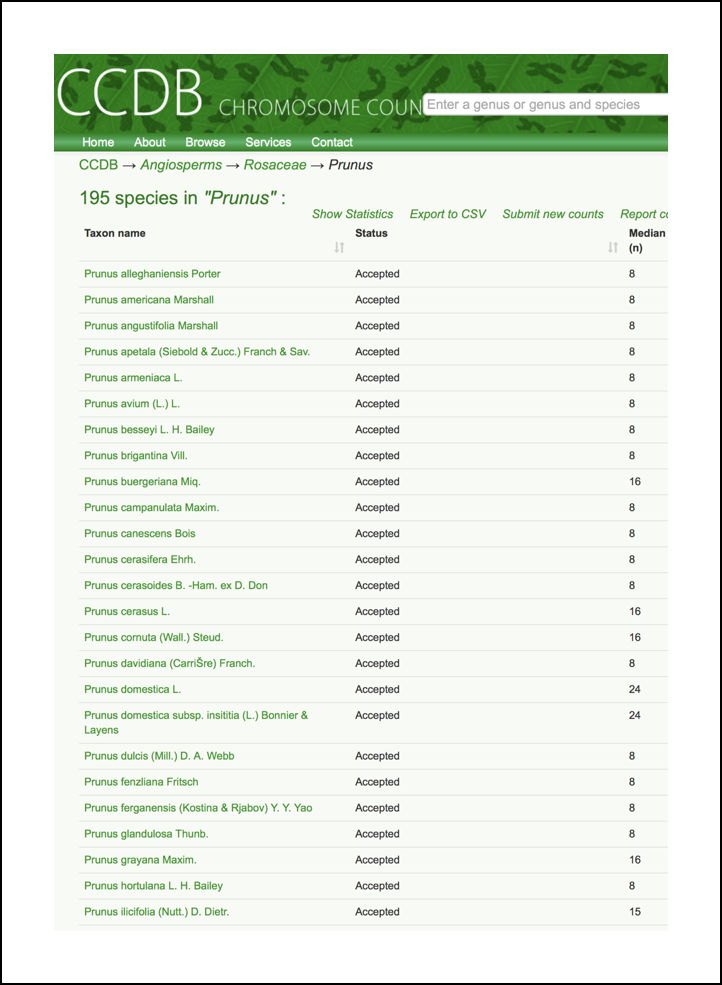
Figure BS803-F3. Some chromosome numbers in Prunus. From [1].
Other plant groups also show loss of selfing ability under drier conditions. Date palms, often isolated in desert oases, always have male and female plants separate, though palms from the jungle are usually self-fertile. Pistachio species normally have male and female flowers on different plants, though their relatives in the Anacardiaceae family, such as cashews, may be self-fertile.
Characteristics of Tetraploids
Tetraploids and other polyploids do occur naturally in nature. Most natural tetraploids are self-fertile. Perhaps because of the increased number of chromosomes in the cell, compared to a diploid of the same genus, an increased cell size seems to come with larger fruits and seeds, shorter nodes and more compact growth, sometimes fleshier leaves.
All these characteristics may be welcomed by the grower of crops. It is possible to treat a diploid plant to turn it into a tetraploid, doubling the number of chromosomes in the cell. This is routinely done using colchicine, a plant biochemical extracted from Autumn Crocus (this extract is also used for treating gout!).
The colchicine is applied in a suitable solution [7] onto growing points of the plant. In a simple nursery use, the solution can be applied to the growing buds of a tree, or a seedling can be inverted and its growing tip dipped in a colchicine solution. Within a plant laboratory, colchicine may be added to the medium in which tissue culture of the plant is being done.
Only a proportion of treated buds or propagules will be chromosome-doubled in this way. Successful doubling may show up rapidly, in the growth pattern of the new tetraploid. Colchicine is carcinogenic, and should only be handled with suitable precautions.
Let us look at some of the plant crops which might be improved through chromosome doubling, and note an important feature of the new tetraploids, the difference between allo-tetraploids and auto-tetraploids.
Coffee
Coffee is the most important tree crop in the world, in terms of world trade [6]. It is far and away the biggest agricultural import item for the United States, the only one measured in billions of dollars annually. The main commercial species is Coffea arabica (commonly called "Arabica coffee"), which originated in Ethiopia.
Arabica is a tropical highland species. Another widely-grown coffee species is Coffea canephora, known as "Robusta coffee". Robusta grows in tropical lowlands, and although its coffee beans are not as well-regarded as those from Arabica, the species has resistance to humid-tropic diseases such as Coffee Blight, to which Arabica is susceptible.
A feature of both coffee species, stemming their from tropical origin, is that the fruits do not ripen all at once, but over extended periods. These coffees can be grown in warm-temperate climates, where growers would like to mechanize production, but the extended ripening period of the fruits makes this difficult.
With the world coffee market being so substantial, it would be attractive if growers in temperate climates could grow varieties of coffee which were self-fertile, would produce well in cooler conditions, and have a short harvest season amenable to machine-picking. There is a way to do this.
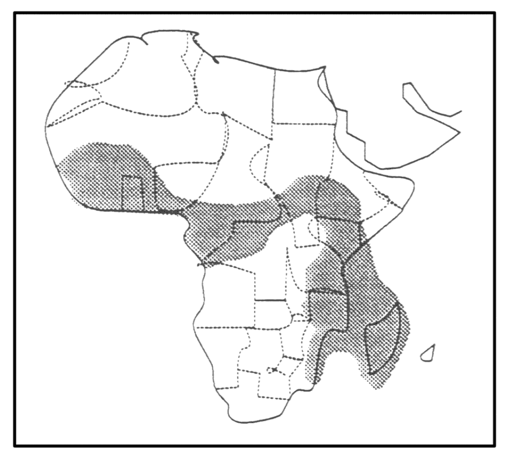
Figure BS803-F4. Natural ranges of coffee species. From [6].
Figure F4 shows the natural ranges of Coffea species. It can be seen that as well as the tropical species, there are species which grow down to temperate areas, including Natal in South Africa and Madagascar. One of these, Coffea racemosa, is native to Natal and produces good coffee.
In [6] it says "An excellent local example is Coffea racemosa, some provenances of which extend right down into Natal (Palgrave, 1988). Palgrave notes that this plant is 'very hardy and resistant to disease; the seeds produce a good and distinctively-flavoured coffee. Fruits mature between October and January'. Particular clones of this species may be expected to have quite short harvest times."
So, there seems to a good possibility for using Racemosa and other coffee species to develop temperate varieties which ripen over a short season and would be amenable to machine harvesting. But there are difficulties to overcome.
Of the coffee species, only Arabica is self-fertile, and will fruit on an isolated plant. It is a tetraploid (4n=44), while the other species are diploid (2n=22) [1], and require cross-pollination. It seems that, at some time in the past, some wild coffee plants underwent chromosome doubling, and these were able to establish themselves as a new, tetraploid species.
In fact, accidental chromosome doubling may occur relatively frequently in wild plants. But the possibility of establishing a new tetraploid species may be small, because a single new tetraploid plant may not be able to find another new, compatible tetraploid in its vicinity with which it can produce viable seeds. It may possibly cross with one of the original diploids, but this would produce a triploid (in coffee, 3n=33), and almost all triploids have vestigial seeds which will not germinate.
Allotetraploids and autotetraploids
There is a further consideration in manipulating the coffee genomes to produce the desired commercial plant varieties. There are two sorts of tetraploid. Doubling a diploid chromosome (2n) with colchicine will produce a tetraploid with two sets of the original chromosomes, and each set will be identical. This is called an autotetraploid.
If you want to develop Racemosa Coffee, a quick way would be to double its chromosome number with colchicine, and then cross the resultant plants with a good Arabica variety. Strictly, the doubled racemosa will be a new species, because the rules state that all individuals in a species must have the same chromosome number. Suppose we call the new species Coffea diracemosa.
Since both all Arabica specimens and all Diracemosa plants will have 44 chromosomes, and they are in the same genus (Coffea), individuals from the two species should intercross readily. With a large number of such Arabica x Diracemosa crosses, it should be possible to select individuals which have a desired combination of traits.
For example, a proportion of such crosses should have a combination of sturdy growth and large bean size from its Arabica parent, plus cold-resistance and seasonality (short harvest period) from its Diracemosa parent. The crosses should also all be self-fertile.
It was suggested in [6] that the introduction of genes for Seasonality from fugitive-domain (shifted by continental-drift type movements) coffee species could transform this major tree crop into a mechanized subtropical product which could be successfully raised well outside its traditional tropical areas
Almonds
Although not as big a trade item as coffee, almonds are also among the major tree crops of the world. The Mediterranean countries are the traditional producers, but during the last 60 or so years the focus of production has shifted to California, where now well over half of the world's almonds are grown.
According to [10], almonds were domesticated at least by 3000 BC, and perhaps much earlier, since wild almonds have been unearthed in Greek archeological sites dating to 8000 BC. The almond was spread along the shores of the Mediterranean in northern Africa and southern Europe by Egyptians, Greeks, and Romans. It was brought to California in the 1700s by Spanish Padres who settled the Mission at Santa Barbara.
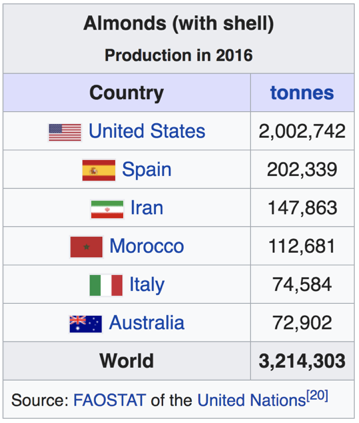
Figure BS803-F5. Major almond producers. From [9].
Around the turn of the twentieth century, the industry started in California, due to development of superior cultivars in the late 1800s [10]. Tariffs on almond imports were levied to protect the industry. From then until about 1960, the industry grew at a moderate pace, but acreage and production have increased several-fold since then, making California the clear world leader in almond production. In 2002, there were over 200,000 hectares of almonds in California, making it the most widely planted tree crop in the state.
All standard commercial varieties of almond are self-incompatible, and require cross pollination. Pollinators (honey bees) are absolutely essential, especially since cool, wet weather can occur at the relatively early blooming period. Californian production of almonds is extremely intensive, and high yields are obtained through massive use of pollinator bees.
According to [9], The pollination of California's almonds is the largest annual managed pollination event in the world, with close to one million hives (nearly half of all beehives in the US) being trucked in February to the almond groves. Much of the pollination is managed by pollination brokers, who contract with migratory beekeepers from at least 49 states for the event. This business has been heavily affected by colony collapse disorder, causing nationwide shortages of honey bees and increasing the price of insect pollination.
Self-compatible almond varieties have been developed by crossing almonds with close Prunus relatives, such as peaches (which do not exhibit the same degree of self-incompatibility), and then back-crossing the hybrids with almonds. By selecting crosses which have acceptable nut production and will self-pollinate, growers can overcome the internal genetic incompatibility which developed in wild almonds. But the process is long-drawn-out and complicated, and the varieties developed do not yet match the merits of the self-infertile varieties.
At the same time, it has been found that attention by bees does improve the pollination of self-fertile almond varieties, even at a much lower hive stocking rate than for self-infertile trees.
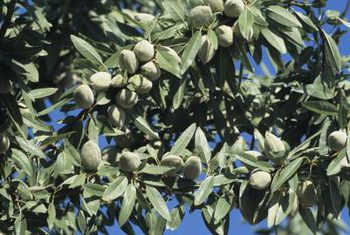
Figure BS803-F6. Almond tree in fruit. From [11].
There is a better and relatively quick way to produce self-fertile almond trees with all the virtues of the best commercial varieties. It can be done by making tetraploids from two or more of the good pollination pairs, and then crossing the tetraploids. Varieties selected from the tetraploid crosses will be self-fertile, and yet have the desired characteristics of their parents.
This perhaps needs a little more explanation. Let us focus briefly on actual varieties of almond popular in California. There is a good listing in [11], from which the following extracts are drawn.
Most almond tree cultivars do require a second tree for proper pollination and are pollinated by the efforts of honeybees. These self-unfruitful varieties that do best in areas of California with the required long, dry summers and adequate chill hours include Ne Plus Ultra, Nonpareil, Carmel, Mission and Price. All of these require a second almond tree of another variety for pollination of the flowers.
Two Nonpareil will not pollinate each other, nor will a pair of Mission, Carmel, Ne Plus Ultra or Price. Ne Plus Ultra makes a good pollinator, except with Price. Nonpareil can pollinate Carmel, Price and Mission almond varieties.
OK, so say you are an almond grower, and you like the varieties Nonpareil and Carmel. These are normal diploids, with 2n=16. First you treat buds or tissue-culture propagules of each to produce tetraploids. Strictly speaking, these tetraploids will be a new Prunus species with 4n=32.
The new tetraploids will grow and produce in the orchard, very much as do their parents. The nuts are likely to be larger than those of their parents, because of the larger cell size. However, they will not be self-fertile, because they are autotetraploids, with exactly the same chromosome sets as their parents, only two of them. A Tetra-Nonpareil tree will need another tetraploid variety, such as Tetra-Carmel, to pollinate it and set fruit.
However, all the fruits produced from this will be allotetraploids (two different chromosome sets in the same cell), and seedlings germinated from these nuts will have various combinations of their parents' genes, according to standard inheritance laws. These seedling crosses will produce flowers which are self-fertile, because they each contain two different gene sets which are known to fertilize each other.
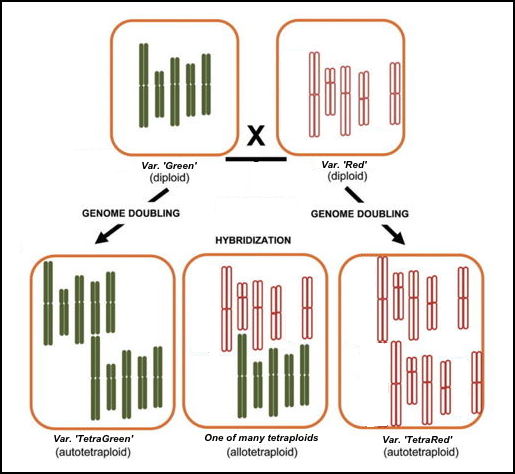
Figure BS803-F7. Autotetraploids and Allotetraploids. Adapted from [8].
This may be clearer from the diagram. The top boxes represent two different varieties of a plant which has 5 pairs of chromosomes (2n=10). We can call these two varieties 'Green' and 'Red'.
Assume that these varieties are self-infertile. What this means, in most cases, is that one (or more) of the chromosomes has a biochemical blockage which stops the chromosome in the female part of the ovary of a variety, from successfully being fertilized by (paired off with) the exactly similar chromosome in a pollen grain of the same variety.
As mentioned earlier, there is no exact reason why a variety should be self-infertile. Indeed, many varieties may self without problems. It is just that Nature has found that discouraging self-pollination is good for the species as a whole, because it forces a more diverse gene pool in the species.
Anyway, say the left-hand chromosome (L1) in the diploid cells of the varieties (top boxes) is the one preventing selfing. A Green L1 will accept a Red L1 in fertilization, but not another Green L1.
Now suppose that each variety undergoes chromosome doubling to give a tetraploid form with a double set of chromosomes in each cell (4n=20). The new TetraGreen variety will still be self-infertile, because all its L1 chromosomes are the same, it is an autotetraploid.
But cross TetraGreen with TetraRed, and every resulting specimen is an allotetraploid, with two quite different chromosome sets (auto=same, allo=different), and this cross will be self-fertile, because it has both Green L1 and Red L1.
Moreover, there will a big range of new varieties in the allotetraploid crosses, because the chromosomes will be randomized in the crosses -- some inherit more Red characteristics, others more Green ones, just as children in the same family will inherit differently from their parents.
Other crops amenable to tetraploidization
Tetraploidization will be of assistance in improving yields of most plant crops which have some pollination problems. We can look briefly at some of these.
Apples, Pears, and Pome fruits.
Most varieties of these fruits need other varieties for pollination, or produce better yields when cross-pollinated. These species have both male and female parts in the same flower.
Pecans and Walnuts.
In these species, male and female flowers are produced on different parts of the same tree, and the timing of the two sexes may not coincide. Selected tetraploid crosses should produce better overlap of male and female flower timing. Mostly wind-pollinated.
Pistachios and Jojobas.
In commercial pistachio varieties, male and female flowers appear on different plants. Male plants do not produce crops. Tetraploidization should give hermaphrodite varieties in which all plants are fruitful.
Dates.
In date palms, male and female inflorescences (flower columns) are on separate trees. For commercial crops, hand pollination is necessary, collecting pollen from male inflorescences and puffing it onto female ones. This is costly. Tetraploid varieties may overcome this.
Papayas.
Papayas are unusual. Male and female flowers may appear on separate plants, or on the same plant. What are classed as 'male' flowers will, in some varieties, produce long fruits (female flowers give rounder fruits). Tetraploiding may improve this situation.
Avocados.
Avocados have unusual fruiting behaviour. There are two types of avocado flowers, referred to as A and B [12]. Each variety of avocado tree will have one or the other type of bloom. The trees flower in a manner known as "synchronous dichogamy."
This means bloom time for male and female flowering is distinct, though the same flower may open as male or female at different times. Type A female flowers are receptive to pollen in the morning and male blooms shed pollen in the afternoon. Type B flowers are receptive to pollen in the afternoon and their male blooms shed pollen in the morning.
However, in spite of this well-established pattern, male/female overlap varies according to locality and weather conditions. In many countries, large commercial avocado orchards contain only the 'Hass' variety, without a cross-pollinator.
Almost certainly, pollination in avocados can be improved through tetraploiding, especially with varieties other than 'Hass'. Possible increase in fruit size may not be welcomed, as current fruit sizes are convenient.
Practical and Commercial considerations
Production of new varieties in tree crops may be slow and involved, as a new variety will need to reach fruiting age before it can be assessed. But with the tetraploid approach, this development process may be considerably shortened.
Once a tetraploid growing point or tissue-culture propagule has been obtained and hardened off, part can be budded or grafted on an already-fruiting tree (diploid or tetraploid) to check the resulting fruit. In this way, new tetraploid fruit varieties may be developed and rated in as little as one year or so.
The tissue-culture option is particularly promising. New propagules can be screened for various characteristics, such as salt tolerance, resistance to cold, and resistance to pathogens, while still in the culture stage. Moreover, once tissue-culture techniques have been developed for the particular clone, plants can be rapidly bulked up in number through repeated culture.
For those seeking to monetize good new tetraploid varieties, Plant Variety Rights are available and easily established, with known genetic makeup. This could make Tetraploiding a valuable tool for the nurseryman or plant supplier, as well as for the orchardist.
Playing around with chromosome numbers
What is said here about tetraploids is just a small part of what could be possible by playing around with chromosome numbers in plants. The field is wide open for exploitation of plant crops, using both cultivated and wild species. Very often, if a particular characteristic is desired in a cultivated crop, it could be abstracted from a wild species in the same family and incorporated.
Also, understanding the chromosome background of any crop you care to look at can throw up suggestions for its improvement, perhaps improvement in yield, greater resistance to pests and diseases, or convenience and lower costs of production.
While chromosome doubling in the laboratory is a useful technique, there are also untold riches available from what Nature has already done in the wild. And a feel for what chromosome numbers imply is a useful background against which to plan.
For example, triploid plants, with 3 sets of chromosomes in the cell, 3n, are well-known in nature. They usually have only vestigial seeds, bad for a crop where the seed is the crop -- but possibly sought after if the fruit is seedless. This could be good with avocados.
With apples, the most popular English cooking apple, the Bramley's Seedling, is a triploid. Budded onto suitable rootstock, it produces above-average size apples, is productive and vigorous, and essentially seedless. Commercial banana varieties are triploids, producing fruit with only traces of seeds, unlike their diploid ancestors, which have fruits crammed with seeds.
The Kiwifruit family, Actinidia, is chromosomally fascinating. Their basic chromosome number is 29 (2n=58), but commercial kiwifruit, of the Deliciosa species, are triploids (3n=87), and so self-infertile, the females needing male plants for pollination. In the wild, most species are diploids (2n=58), a few are tetraploids (4n=116), and at least one is an octoploid (8n=232).
Doubling chromosome numbers, and perhaps doubling again, seems to give advantages in selfing and fruit size. Modern strawberry varieties, with their large fruits, are based on a natural octoploid from Chile. Strawberry species and hybrids can be diploid, tetraploid, pentaploid, hexaploid, heptaploid, octoploid, or decaploid.
So here is a fascinating field of science in which so much remains to be uncovered. This does give a wry nod to the Shakespeare quotation at the head of this article, "To thine own Self be true".
* * * * * * * * * * * * * * * * * *

References and Links
[1]. Chromosome Counts Database. http://ccdb.tau.ac.il/search/ .
[2]. Sara & Ivan. Plant Cell Chromosomes. https://www.youtube.com/watch?v=jJi8Mbb5tLk .
[3]. What is the difference between a chromosome and chromatid? https://www.quora.com/What-is-the-difference-between-a-chromosome-and-chromatid .
[4]. Self-incompatibility. https://en.wikipedia.org/wiki/Self-incompatibility .
[5]. Peter E Gibbs. Late-acting self-incompatibility -- the pariah breeding system in flowering plants. https://nph.onlinelibrary.wiley.com/doi/full/10.1111/nph.12874 .
[6]. David Noel. Fugitive Earth Domains as Sources of Useful Fruit and Nut Genes. http://wayback.archive-it.org/1941/20100524190449/http://www.wanatca.org.au/Q-Yearbook/Y14all.pdf .
[7]. Effects Of Colchicine Treatments On Chromosome Doubling In Three Diploid Cotton Species. https://pdfs.semanticscholar.org/d784/a55df7611cba12bf8e27a6c02f070bb6d3b3.pdf .
[8]. Whole genome duplications in plants: an overview from Arabidopsis. https://watermark.silverchair.com/erv432.pdf .
[9]. Almond. https://en.wikipedia.org/wiki/Almond .
[10]. Mark Rieger. Almond -- Prunus dulcis. http://www.fruit-crops.com/almond-prunus-dulcis/ .
[11]. Does an Almond Tree Require a Second Tree to Pollinate?. http://homeguides.sfgate.com/almond-tree-require-second-tree-pollinate-42472.html .
[12]. Amy Grant. Pollinating Avocado Trees: How To Cross Pollinate An Avocado Tree. https://www.gardeningknowhow.com/edible/fruits/avocado/pollinating-avocado-trees.htm .
[13]. Triploid apple varieties updated. https://www.orangepippin.com/resources/triploid-apple-varieties-updated .
Go to the Base Sciences Home Page
Version 1.0 compilation started 2018 Jun 15, on Web 2018 Jun 27.










